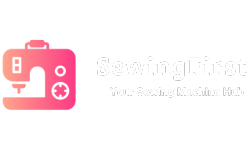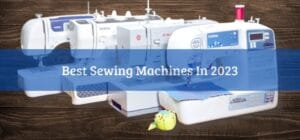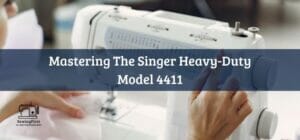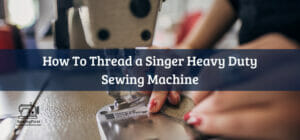Have you ever wondered what all those dials, knobs, and levers were on your sewing machine? Are you familiar with the lever-like arm conveniently tucked away under the main part of the machine? That lever is known as a free arm.
But what exactly is it? In this article, I’ll explain exactly what a free arm is and how it impacts your sewing projects.
As you’ll see, this interesting little arm can open up a whole world of sewing possibilities. By having a basic understanding of what is a free arm on a sewing machine and how they function, you can take advantage of their capabilities to become an even better seamstress or tailor!
Related Topic: What is a Knee Lift on a Sewing Machine? (+ How to Use It)
Table of Contents
ToggleWhat Is A Free Arm Sewing Machine?
A free arm sewing machine is a portable sewing machine that has one side designed to be removable. This allows the user to easily sew sleeves and pant legs without having difficulty maneuvering around them. It’s also ideal for making cuffs, collars, and other hard-to-reach areas. The free arm adds flexibility when it comes to creating garments or accessories with difficult pieces and shapes.
Using a regular flatbed machine can make certain projects more complicated than necessary, but with a free arm, you don’t have that problem.
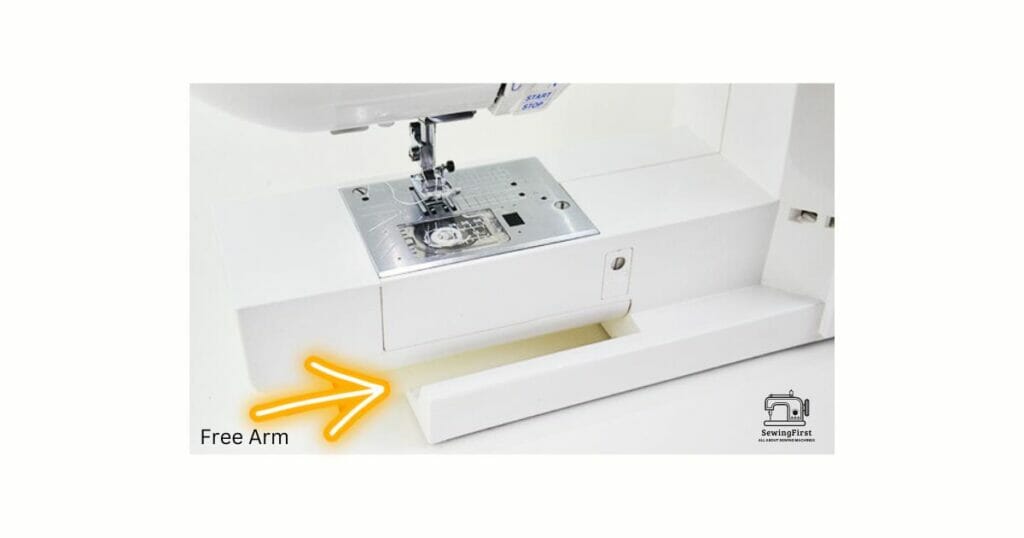
Not only does this feature help with intricate stitching, but it makes projects easier overall since you don’t need extra tools like bias tape or seam rippers in order to work on delicate fabrics. Plus, most machines come equipped with extra presser feet that are made specifically for free arms – adding even further versatility to your project possibilities!
With added convenience and control over your fabric edges and corners, sewing becomes much simpler. Whether you’re an experienced sewer looking for an upgrade or just starting out – investing in a free-arm sewing machine can definitely benefit any level of a skill set!
Benefits Of A Free Arm Sewing Machine
A free-arm sewing machine is a great tool for sewers of all levels. It offers many benefits that can make projects easier and help create more professional-looking garments and home decor items.
- Provide increased control over the fabric.
- Allow access to hard-to-reach areas.
- For starters, one of the biggest advantages of using a free arm is that it helps with maneuvering fabrics around tight spots or curves.
- It comes in handy when working on hems or cuffs since it provides easier access to those smaller spaces.
- Greater control over your material means you’re able to work more precisely with fewer mistakes.
- Being a portable sewing machine, you can move it easily.
With an ordinary flatbed machine, it’s harder to track where you are in the pattern while controlling multiple layers of fabric—but not so with a free arm!
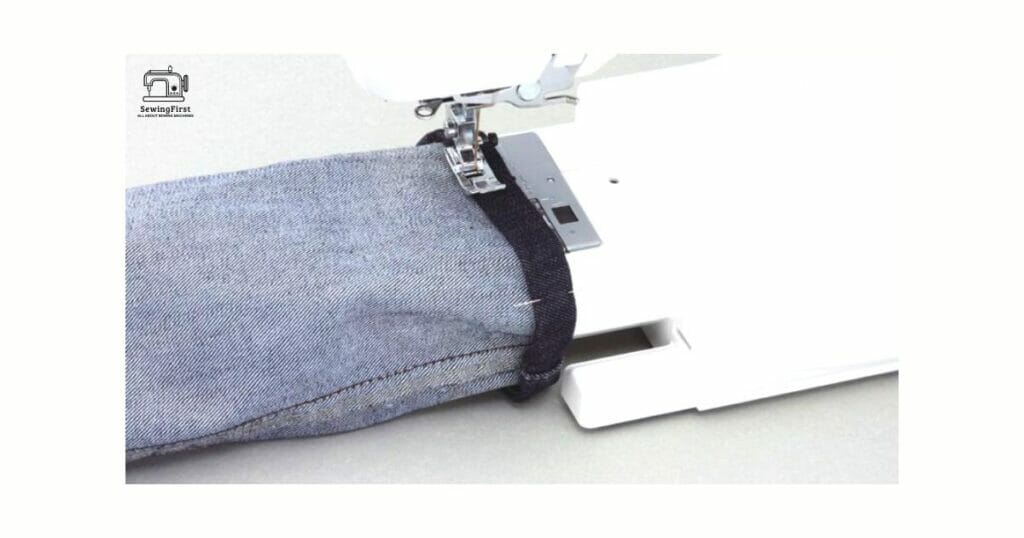
Overall, owning a free-arm sewing machine can take your skillset up a notch. As long as you understand how its features will affect your project, this type of machine can be incredibly helpful when trying to get things just right without wasting time or materials along the way.
Whether tackling challenging garments or adding intricate details like piping and pleats, a free-arm sewing machine does wonders for creating beautiful pieces quickly and efficiently.
Features of a Free Arm on a Sewing Machine
The free arm on a sewing machine is an incredibly useful tool that allows you to sew around curved surfaces and awkward shapes with ease.
It can be especially helpful when sewing sleeves or cuffs that have tight curves. Not all machines come with this capability out of the box, but it’s worth researching if your model has a free-arm option available.
One of the most important features of a free arm sewing machine is its twin needle capability, which allows you to sew two parallel lines at once for decorative stitching or hemming. Additionally, many models come with a wide table attachment that provides extra space for larger projects such as quilts or curtains.
Other features include a zipper foot, automatic needle threader, various sewing feet, drop-in bobbin, buttonhole foot, built-in thread cutter, and feed dog. The stitch functions vary depending on the model but usually include straight stitching, zigzag stitching, and blind hemming. Some machines also offer quilting capabilities and an arm machine for more intricate designs.
By taking advantage of these features, you can create beautiful garments with ease! With just a little bit of effort and regular maintenance checks like cleaning and lubricating the moving
Differences Between A Flatbed And Free Arm Sewing Machine
When it comes to sewing machines, the two main types are flatbed and free arm. But what makes them different?
For starters, a flatbed sewing machine has an even surface that is suitable for most projects – making straight stitches or quilting. On the other hand, a free arm sewing machine has a cylindrical space at one end of its bed which provides access to curved areas where you can sew hems and cuffs more efficiently than on a flatbed.
The difference between these two types of machines also extends to their size: while flatbeds tend to be larger in size, free arms are smaller and easier to store away when not in use. Additionally, they’re great if you want something portable as they don’t take up much space.
This means you can bring your machine with you wherever you go without having to worry about whether it will fit through doorways!
Overall, each type of sewing machine offers specific advantages depending on the project at hand; some tasks require the use of a large flatbed whereas others require maneuverability offered by a free arm design.
At the same time, there are many models available so regardless of what kind of job needs doing, you’ll be sure to find one that meets your needs perfectly.
Understanding The Different Types Of Free Arm Industrial Sewing Machines
When it comes to industrial sewing machines, a free arm is an important feature. A free arm allows the user to sew in tight spaces and get into small corners with ease. It’s also great for circular items like cuffs or sleeves which need extra maneuverability when being worked on.
Most standard flatbed industrial sewing machines don’t have a free arm – these are usually less expensive and best suited for straight-line stitching only. Free arms can come as part of the machine itself, or they can be added on as an optional accessory depending on the manufacturer.
Free arm industrial sewing machines allow users to work faster, and more accurately and reach places that other types of machines simply can’t. They’re especially useful for complex projects such as making costumes, upholstery, and tailored clothing where intricate details must be attended to precisely.
Their ability to make previously hard jobs easier makes them invaluable assets in any commercial setting where time savings are essential.
Factors To Consider When Buying A Free Arm Sewing Machine
When looking for a free arm sewing machine, there are several factors to consider.
- Ensure the product has good customer reviews and ratings. This can provide peace of mind that you’re investing in a reliable model which will last.
- Check what type of device it is; some machines have more features than others, such as built-in stitches or automatic threading functions.
- Ascertain how much space you have available; this could influence your decision on whether to opt for an industrial size or a smaller home version.
- Think about budget – do you want to invest in something with lots of features or just get a basic model?
- You should also take into account any extra accessories needed and make sure these are compatible with the chosen machine. This might include bobbins, needles, and presser feet for specific fabrics.
- Double-check what warranty is included so that if anything goes wrong within the set time period then repairs can be made easily and quickly at no additional cost.
Investing in a quality free arm sewing machine need not be difficult if all these points are taken into consideration before making a purchase.
What Types Of Projects Are Best Suited For A Free Arm Sewing Machine?
Using a free arm sewing machine can be beneficial for certain types of projects, but it is important to know what those projects are before investing in one. So what exactly are a free arm on a sewing machine and which kinds of tasks can best make use of this feature?
A free arm on a sewing machine is an extension that detaches from the main body. It allows users to access hard-to-reach areas when working with curved or circular objects like cuffs, collars, and waistbands.
This extra part also helps when dealing with small items such as pockets and hems. In addition, it makes it easier to maneuver fabric around without having to move the entire cloth piece.
The most common uses for a free arm include tailoring and quilting. Tailors often need to sew intricate pieces that require precision; being able to access difficult corners quickly and accurately saves time and energy.
Quilters may find that using a free arm gives them better control over their material as they work with multiple layers of fabrics at once. Moreover, it provides added convenience since they don’t have to keep adjusting or repositioning the fabric while stitching.
Overall, anyone who wants more precise results when tackling specific types of projects should consider buying a model equipped with a free arm attachment. With its help, tedious jobs become simpler and quicker—allowing you to focus your creative energies elsewhere!
Different Stitch Options Offered By A Free Arm Sewing Machine
A free arm sewing machine offers a variety of stitch options to complete any project. It is an ideal choice for those who want to sew difficult shapes or items with tight curves as it allows you to move the fabric around easier while stitching. The primary benefit of this type of machine is its versatility in terms of stitching capabilities.
For instance, most machines offer standard straight and zigzag stitches that are perfect for basic hems and seams. Additionally, they also come equipped with decorative stitches like scallops and waves which help create intricate designs on garments and other fabrics.
Furthermore, many models have built-in stretch stitches specifically designed for knit fabrics so that your finished product will be able to withstand wear and tear better over time.
These types of machines are also great for quilting projects due to their ability to produce precise uniform lines in both straight and curved patterns. As well, some models even include special quilting feet attachments that can make it much easier for users to evenly feed multiple layers of material through the needle at once.
With such a wide range of features available from these machines, anyone looking to get creative with their crafting will certainly find plenty to work with!
Tips For Using A Free Arm Sewing Machine
Using a free arm sewing machine can be an intimidating process, but with the right tips, it can actually be quite straightforward. The first step is to understand what a free arm does and how it’s different from other types of machines.
A free arm gives you access to hard-to-reach areas on your fabric that typical sewing machines just don’t have. With this extra reach, you’re able to sew curved hems and sleeves, as well as apply decorative stitching in narrow spaces.
Now that you know why a free arm is so useful, let’s look at some tips for using one successfully.
- One thing to keep in mind when working with a free arm is that the foot pedal will only move the needle up or down – not side-to-side as many standard models do. This means you’ll need to manually adjust the fabric yourself whenever necessary.
- Make sure the presser foot lever stays engaged while you work; this keeps the pressure on your fabric consistent throughout each stitch line.
- Set your tension setting before starting any project and practice controlling both speed and pressure on your fabrics until they become second nature. Doing so will help ensure accurate results every time!
Troubleshooting Common Problems With Free Arm Sewing Machines
Troubleshooting common problems with free arm sewing machines can be a tricky task. Luckily, there are some tips and tricks that you can use to get the job done quickly and easily.
- Check for any visible obstructions on or around the machine before beginning your troubleshooting process.
- Look for pieces of fabric, thread, lint, or even buttons that might have gotten caught in the mechanism. If you find anything stuck in the machine, gently remove it so it doesn’t interfere with your work going forward.
- Make sure your needle is properly seated into its holder and secure enough not to move while stitching. This may require you to adjust the screw at the base of the needle holder as well as ensure that the clamp holding down the presser foot is tight enough.
- Ensure that all other moving parts such as gears and cogs are functioning correctly by lubricating them if necessary.
- Take time to read through your manual carefully and follow any instructions specific to your model very closely in order to address any potential issues that arise with using a free arm sewing machine.
By taking these steps before starting any project, you’ll be better prepared when something does go wrong during use and able to fix it without needing outside help!
Maintaining A Free Arm Sewing Machine
Maintaining a free arm sewing machine is an important part of keeping it in good working order. Regular maintenance can help to extend the life of your sewing machine and prevent problems from occurring down the line.
It’s also important to make sure that all moving parts are properly lubricated, as this will keep them running smoothly over time. For best results, use only the recommended oil for your particular model when lubricating any components.
When cleaning a free-arm sewing machine, be especially careful around electrical contacts and other sensitive areas. If you’re unsure about what should be done with these areas, consult your manual or contact customer service for advice before attempting to clean them yourself.
Additionally, take care not to damage any delicate plastic pieces when removing lint or dust buildup from various components on the machine.
To ensure optimal performance, always check that all screws and moving parts are tightened securely after each use.
This will help avoid unnecessary wear and tear on the internal mechanisms of your machine, allowing it to continue functioning at its best for years to come.
Moreover, inspect all belts and pulleys regularly for signs of cracking or fraying which could lead to mechanical malfunction if left unchecked. By performing regular maintenance checks like these, you’ll be able to enjoy trouble-free stitching every time you sit down at your free arm sewing machine!
Conclusion
In conclusion, the free arm on a sewing machine can be a great tool when sewing certain projects. It allows you to sew in areas and around curves that you may otherwise not be able to reach with standard machines.
Now that you know what the free arm is and how it works, you are better equipped to make the most out of your sewing machine’s features. With the right knowledge and practice, you can create amazing projects with ease using your free arm!
FAQs
Do you need a free arm sewing machine?
Yes, a free arm sewing machine can be very useful for certain projects. It allows you to sew in areas and around curves that you may otherwise not be able to reach with standard machines. With the right knowledge and practice, you can create amazing projects with ease using your free arm!
What is a free arm sewing machine used for?
A free arm sewing machine is used for projects that require more precise stitching, such as hemming pants or sleeves. It can also be used to sew in tight spaces and around curves that are difficult to reach with standard machines.
